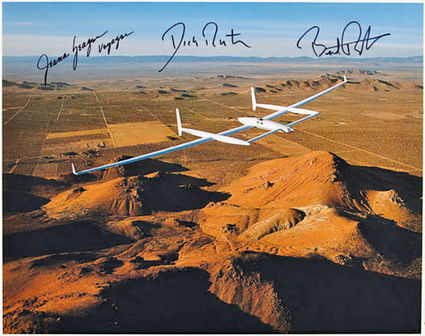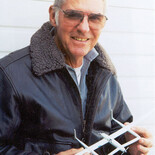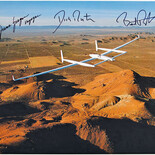The Voyager story
Short Flights
The Voyager story is one of great emotion, courage, vision and adventure and is often referred to as "aviation's last first."
The aircraft and idea of flying around the world non-stop was first discussed over a lunch with Jeana Yeager, and Burt and Dick Rutan. Ever the engineer, Burt starting sketching his idea of the aircraft on a paper napkin. The rest is history.
Primarily individual contributions, and a few product equipment sponsors financed the Voyager. The project did not receive any government sponsorship.
On a wing and a dream, a small group of people set out to achieve the impossible - to fly around the world without stopping and without refueling. It was originally believed the project would take about 18 months. Design, construction, flight route and permissions, and testing stretched that 18 month projection to nearly six years. In early Dec. of 1986, Voyager was flown to Edwards Air Force Base in California. She was fueled for hours and on December 14, 1986, Voyager took off on what would become The World's Longest Flight.
Voyager made the extraordinary first-ever non-stop, unrefueled flight, around the world with pilots Dick Rutan and Jeana Yeager (no relation to Chuck Yeager). This marked the 69th flight of Voyager.
Numerous test flights were made before the record breaking milestone flight, plus a flight to Oshkosh, Wisconsin to attend the annual Experimental Aircraft Association's fly-in.
Burt Rutan, famous aircraft designer and CEO of Scaled Composites at Mojave Airport, created Voyager for maximum fuel efficiency. Bruce Evans, Crew Chief and a host of volunteers built this graceful design at Mojave Airport.

Ever present was friend and pilot Mike Melvill who was flying the chase plane when Voyager took off from Edwards AFB with Burt Rutan in the right seat calling out to his brother, Dick, on the radio. It was always the calming voice of Mike Melvill during the dangerous test flights that could calm the uncertainties felt in the Voyager cockpit.
The circumnavigation flight was 26,366 statute miles, which more than doubled the previous record set by a B-52 Bomber in 1962. This fragile looking aircraft, with a wingspan of 110.8-feet, had an empty weight of only 939 pounds. The gross weight on take-off from Edwards AFB, December 14, 1986, was 9,694.5-pounds. Voyager was equipped with two Teledyne-Continental engines (front engine O-240, 130 hp and rear engine IOL-200, 110 hp), was a twin-boom, single wing homebuilt aircraft designed for long-distance flight and had 17 fuel tanks.
The milestone flight took nine days, three minutes and 44 seconds and the absolute world distance records set during that flight remains unchallenged today. The flight was sanctioned by FAI (Fédération Aéronautique Internationale).
Mid-flight, when Voyager crossed the coast near Mogadishu and headed toward Nairobi, they had a happy and planned rendezvous with a chase plane, supplied by Sunbird Aviation and carrying Doug Shane of Scaled Composites. Doug pulled the aircraft abeam the left side of Voyager and told Dick and Jeana everything looked fine as he inspected the aircraft.
The cramped cockpit environment was most uncomfortable and sleep deprivation was the enemy.
Imagine being locked in a phone booth for nine days while flying at speeds of only 80-knots navigating around thunderstorms, getting near hostile countries that threaten to shoot you down, worrying about whether or not you have enough fuel for the trip, running on one engine to conserve fuel and on the last leg of the flight you suffer rear engine failure, due to an air pocket in a fuel line. While attempting to start the front engine, you lose 5,000 feet of altitude, spiraling down as the ocean comes up to meet you and just then, the front engine catches and roars to life, and at that moment saves yours! That is only one of the many life threatening moments that prevented these two pilots from sleeping or eating much. It's impossible to even think of eating or sleeping when you are terrified.
There were thousands of people at Edwards Air Force Base to witness the landing of Voyager on Dec. 23, 1986.
Four days after landing, President Ronald Reagan presented the Voyager crew and its designer with the Presidential Citizenship Medal. Awarded only 16 times previously in history.
For their record-breaking flight, the pilots, Dick Rutan and Jeana Yeager, the designer, Burt Rutan, and the crew chief, Bruce Evans, earned the Collier Trophy in 1986, aviation's most prestigious award.
Often when Dick Rutan recalls the Voyager story, he will give his mother, Irene Rutan credit for inspiring him. "She always said, 'if you can dream it, you can do it, and the only way to fail is to quit',"
Voyager, a piece of Mojave aviation history, now hangs in the Milestones of Flight South Lobby of the National Air and Space Museum in Washington D.C.
Next time you see Dick Rutan, ask him to tell you what he says when he stands under that airplane when he visits the museum – you will remember his words every time you visit the Voyager!

Jeana Yeager
Come and hear the Voyager Story from the Rutan Brothers and all who were part of this tremendous, successful effort on Dec. 17, 2016 at Mojave Air and Spaceport. Make your reservations today at http://www.mojavemuseum.org or http://www.mojaveairport.com for the 30th Voyager Anniversary Banquet!







